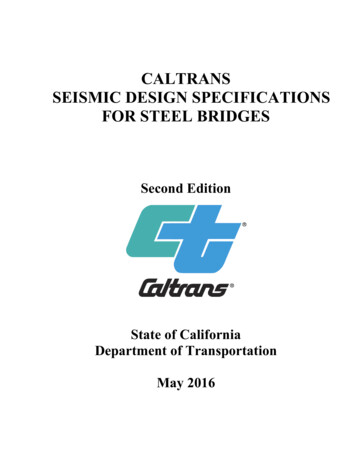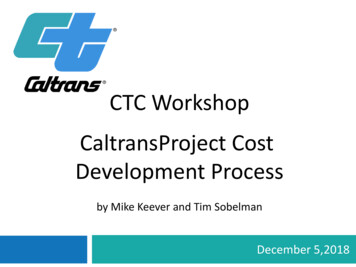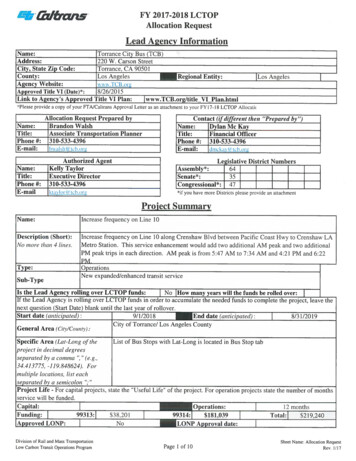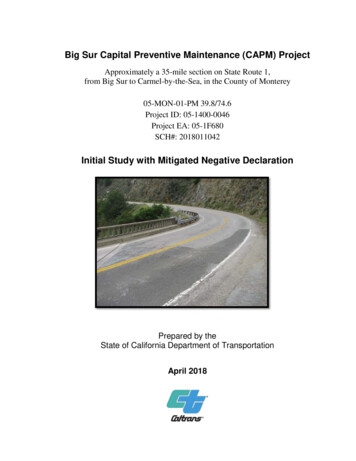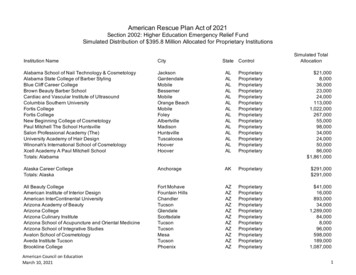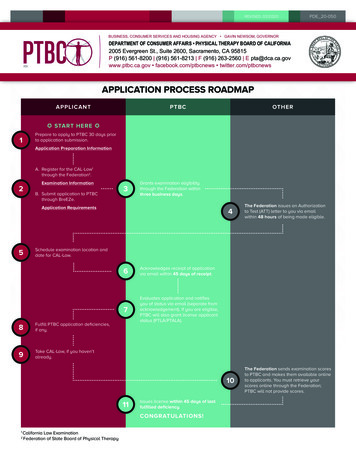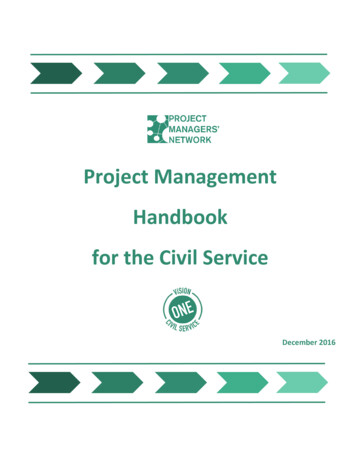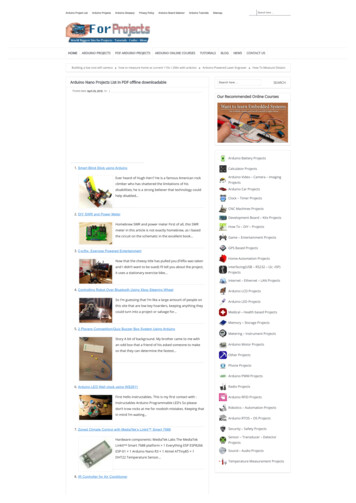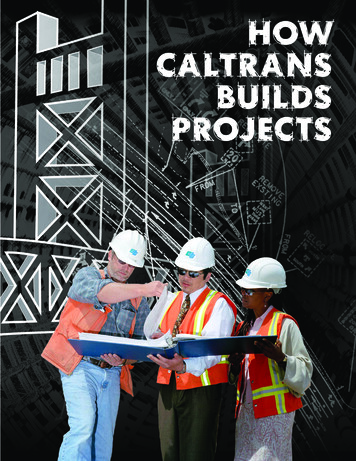
Transcription
HowCaltransBuildsProjects
How Caltrans Builds ProjectsTHIS BOOKLETThis booklet gives a concise overview of the California Department ofTransportation (Caltrans) project delivery process for projects that will improveor maintain the State Highway System (SHS) including the Interstate System.This booklet also provides a list of resources for further reference. In addition tocontacting local district staff with questions pertaining to their area of expertise,information may be obtained via the Caltrans web portal: http://www.dot.ca.gov orhttp://www.dot.ca.gov/doingbusiness.htm.
.How CaltransBuilds ProjectsIdentifyProject NeedTable of ContentsIntroduction . 3Identify Project Need . 4Decision to PrepareProject InitiationDocumentForm ProjectDevelopment TeamDecision to Prepare Project Initiation Document . 6Form Project Development Team . 7Prepare Project Initiation Document . 8Prepare ProjectIntiation DocumentSecure ProjectProgrammingSecure Project Programming . 9Prepare Draft Project Report . 10Perform Environmental Studies . 11Prepare DraftPerformProject Report Environmental StudiesSecure ProjectApprovalPreparePS & EAcquire Obtain Approvals,AgreementsRights of Way& PermitsCompleteProject DesignSecure Project Approval . 12Prepare PS & E . 13Acquire Rights of Way . 15Obtain Approvals, Agreements & Permits . 16Complete Project Design . 19Prepare & Advertise Contract . 20Prepare &Advertise ContractContract Administration&Construction of ProjectContract Administration & Construction of Project . 21Project Close-out . 21Conclusion . 23ProjectClose-outResources . 24Acronyms . 25
.How CaltransBuilds ProjectsIntroductionCALTRANS MISSIONCaltrans Mission is to ‘Improve Mobility Across California’. It accomplishes thismission through a variety of programs set up by the California Legislature, including: The State Highway System (SHS) (includes the Interstate System) Mass Transit (bus and light rail) Aeronautics (airports) Rail (Amtrack and Caltrain) Local Roads (support for projects using state and federal funds)CALTRANS ROLE IN DEVELOPING PROJECTSON THE SHSCaltrans, as owner-operator of the SHS, has the authority and obligation to ensurethat all modifications or additions to the SHS, regardless of the project sponsor orfunding source, are: Safe, operational, maintainable, compatible, and of good value Providing efficient multimodal movement of people and goods In the best interest of the general public Developed and constructed in compliance with laws and regulations that governthe use of state and federal transportation funds Developed and constructed in partnership with vested stakeholders3
.How CaltransBuilds ProjectsIdentifyProject NeedDecision to PrepareProject InitiationDocumentForm ProjectDevelopment TeamPrepare ProjectIntiation DocumentSecure ProjectProgrammingPrepare DraftPerformProject Report Environmental StudiesSecure ProjectApprovalPreparePS & EAcquire Obtain Approvals,AgreementsRights of Way& PermitsCompleteProject DesignPrepare &Advertise ContractContract Administration&Construction of ProjectProjectClose-outIDENTIFYING PROJECT NEEDHOW PROJECTS GET STARTEDConsiderable planning is performed either by Caltrans, a local agency, or jointlybefore project development starts. A transportation need is identified, either asa structural or operating deficiency of the existing transportation system or as aresponse to planned land use changes such as a new subdivision, shopping center, ormanufacturing center. Identification of such a need may result in a project as minor asa traffic signal or as major as a freeway or a multimodal connection (bus/rail/transitconnection to the SHS).If a major project such as a freeway or transit system on the SHS is needed,Caltrans or a regional planning agency must perform studies to compare potentialtransportation investments before deciding what to build.Project needs are identified through Caltrans management systems, master plans,system and regional plans and prioritizing processes. These focus on transportationproblems and solutions by establishing objectives and preliminary scoping. Afeasibility planning estimate may be prepared to validate the project’s objectives. Atthis point, a project is little more than a planning concept with location and generaldeficiency identified.SYSTEM AND REGIONAL TRANSPORTATION PLANNINGSystem and regional transportation planning, other processes mentioned above, andmaster plans identify the need for transportation projects.Transportation planning is long-range (20 years), area-wide, and developed withthe involvement of federal, state, regional, and local agencies; public entities, privateand community-based organizations; the general public and individuals workingtogether to identify future transportation needs and to plan for how these needs canand will be met. The goal of transportation planning processes is to prepare andprovide for mobility for all travelers in a fiscally and environmentally responsiblemanner consistent with environmental, social, economic, financial, political, land use,and equity information and addressing community goals. Transportation planningprocesses are based on federal transportation law: it is continuing, cooperative,and comprehensive. It is ongoing, not a single completed action. All modes oftransportation are considered in the planning process, and all affected stakeholdersare involved.4
.How CaltransBuilds ProjectsIdentifyProject NeedDecision to PrepareProject InitiationDocumentForm ProjectDevelopment TeamPrepare ProjectIntiation DocumentSome of the goals of the transportation planning process, under the overall mission toimprove mobility across California are: SAFETYProvide the safest transportation system in the nation for users and workers. MOBILITYMaximize transportation system performance and accessibility. DELIVERYEfficiently deliver quality transportation projects and services. STEWARDSHIPPreserve and enhance California’s resources and assets.Secure ProjectProgrammingPrepare DraftPerformProject Report Environmental StudiesSecure ProjectApprovalPreparePS & EAcquire Obtain Approvals,AgreementsRights of Way& PermitsIn 1997, Senate Bill 45 placed 75 percent of State Transportation ImprovementProgram (STIP) funds under the control of California’s regional agencies through aprogram called the Regional Transportation Improvement Program (RTIP). In theregions, projects are nominated by cities, counties, Caltrans and others for inclusion inthe RTIPs. Projects compete with one another through a process that is established bythe region. Caltrans districts assist the regional agencies, where requested to do so, indeveloping regional plans. Caltrans is the steward for projects proposed on the StateHighway System, and as such oversees the state and federal processes and approvalsapplicable for these projects, regardless of funding source or project sponsor.WHY BUILD IT?CompleteProject DesignPrepare &Advertise ContractContract Administration&Construction of ProjectA project must satisfy a clearly defined purpose and need. Planning documents theregions’ transportation deficiencies and describe the underlying transportation needs.In parallel, projects are proposed to meet that need or resolve the transportationproblem identified along with addressing environmental, social, cultural, economiccommunity, aesthetic, historic, and scenic goals. The specific objective of the projectbecomes the purpose. Planning documents are required to be fiscally constrained,comprised of projects that are realistically fundable.ProjectClose-out5
.How CaltransBuilds ProjectsIdentifyProject NeedDecision to PrepareProject InitiationDocumentForm ProjectDevelopment TeamPrepare ProjectIntiation DocumentDECISION TO PREPARE PROJECTINITIATION DOCUMENTProjects from the planning documents are selected by each district or region for furtherstudy subject to various considerations, including regional agency priorities. The resultof these studies is a Project Initiation Document (PID). Before committing resourcesto a PID, a short decision document discussing the feasibility of initiating the projectis prepared. This document usually includes a strip map and feasibility planningestimates. All STIP (or RTIP) projects on the State Highway System require a PID inorder to be programmed. Programming is the commitment to fund a project, usuallywith dollars from the State Highway Account (see the section on Secure ProjectProgramming later in this booklet for more information on this subject and otherfunding sources).PROJECT INITIATIONSecure ProjectProgrammingPrepare DraftPerformProject Report Environmental StudiesSecure ProjectApprovalPreparePS & EAcquire Obtain Approvals,AgreementsRights of Way& PermitsCompleteProject DesignPrepare &Advertise ContractContract Administration&Construction of ProjectProjectClose-outThe PID is written to provide stakeholders, decision –makers, and “next-phase”PDT members with a broad understanding of the transportation deficiency andthe proposed project’s objective to resolve the deficiency. The PID informs thereader of the key issues and assumptions regarding the commitments on the scope,schedule and estimated cost of the project. The PID must provide a sound basis forcommitment of future state funding.The PID is an analysis of major issues such as constructability, traffic operations,multimodal mobility, finance, railroad and utility involvement, transportationmanagement, environmental questions, community involvement, and identificationof individuals and institutions that are likely to be affected by the project. The PIDanalysis of these issues is against a framework of multimodal alternatives designed tomeet the project purpose and need.PIDs vary in outline and extent based on the funding source and the complexity ofthe project. Generally, the origination of any new STIP (or RTIP) project on the StateHighway System requires a PID document called a Project Study Report (PSR). Forlarger, complex projects that take many years to program, another PID document,the Project Study Report (Project Development Support) can be prepared. Formost projects proposed to use State Highway Operational and Protection Program(SHOPP) funds, a Project Scope and Summary Report (PSSR) is the PID that isprepared. These reports are substantial engineering documents that contain a reportof preliminary engineering, a detailed alternatives analysis, and cost, schedule, andscope information. The format for these reports is contained in the appendices ofthe Project Development Procedures Manual (PDPM) and is covered briefly in thesection on Prepare Project Initiation Document.6
.How CaltransBuilds ProjectsIdentifyProject NeedDecision to PrepareProject InitiationDocumentForm ProjectDevelopment TeamPrepare ProjectIntiation DocumentSecure ProjectProgrammingPrepare DraftPerformProject Report Environmental StudiesSecure ProjectApprovalPreparePS & EAcquire Obtain Approvals,AgreementsRights of Way& PermitsPIDs are prepared by project teams under the leadership of a project manager. Formalproject development starts when a Caltrans project manager is named and secures anexpenditure authorization. A project work plan is developed by the project manager,which covers the effort needed to produce a PID. The work plan includes theresources and disciplines needed to develop the PID, the identification of the affectedstakeholders and a communication plan.FORM PROJECT DEVELOPMENT TEAMProject Development Teams (PDTs) are used throughout the project developmentprocess, from feasibility studies to the completion of the project. Essentially, the PDTis the steering committee for the project, with a larger project team performing theroutine project development activities. In developing the PID, the PDT refines theproject’s purpose and need, employs different disciplines (such as value analysis)to develop and evaluate alternatives, helps project managers direct studies, makerecommendations, and carry out the project work plan through subsidiary teammembers. Members of the PDT participate in major meetings such as public hearingsand community involvement. They are responsible for the conduct of studies andaccumulation of data. For larger, more complex projects, PDTs are extended andformalized (as required by law) to include a wide range of disciplines and individualsfrom outside agencies and may even include representatives from community groups.PROJECT DEVELOPMENT TEAM FUNCTIONSIn the PID stage, the PDT has these primary functions:CompleteProject DesignPrepare &Advertise ContractContract Administration&Construction of ProjectProjectClose-out Determine logical project limits Determine the need for participation of local, regional, state, or federal agencymembers, or the need for advisory committees Recommend alternatives, timetables, type of environmental documentsupporting studies, and the feasibility of environmental mitigation measures Call upon various disciplines as needed to ensure thorough analysis of thesocial, economic, environmental, and engineering aspects of the project Initiate community involvement designed to obtain input on the project and helpplan public meetings and hearings Ensure that state and federal requirements are met Establish a Quality Assurance procedure to assure that stakeholder needs orexpectations are met or exceeded7
.How CaltransBuilds ProjectsIdentifyProject NeedDecision to PrepareProject InitiationDocumentForm ProjectDevelopment TeamPrepare ProjectIntiation DocumentSecure ProjectProgrammingPrepare DraftPerformProject Report Environmental StudiesSecure ProjectApprovalPreparePS & EAcquire Obtain Approvals,AgreementsRights of Way& PermitsCompleteProject DesignPrepare &Advertise ContractContract Administration&Construction of ProjectSubsequent to the PID development, PDTs: Participate in a reevaluation of preliminary engineering data and systemsplanning recommendations to confirm that the study should continue Recommend a preferred alternative to district management Ensure design of a quality project that can be safely and efficientlyconstructed and maintained within scope and budget and on schedule Ensure that right-of-way is acquired and cleared on schedule Provide advice during construction Ensure that the project history is preservedPREPARE PROJECT INITIATIONDOCUMENTThe main purpose of a PID is to define the project’s scope, cost and scheduleand obtain conceptual approval within Caltrans, who is the owner/operator of theSHS. Secondarily, the PID is used to scope a project to be used as a candidate forprogramming.Before a project team can perform its functions successfully, it is crucial togain consensus on the project’s purpose and need. The PDT must identify thetransportation deficiencies and describe the underlying transportation need.The first step in this stage of project development is agreement on the primaryobjectives (the purpose of the project) that will be fulfilled by constructing theproject. Once this is complete, decisions can be made as to the informationnecessary to develop alternatives that will address the project’s purpose andneed. The result of this process is the PID. The study of each alternative, whetherdetailed or cursory, includes: Design concepts Multimodal options Operational improvements Associated costsProjectClose-out Environmental considerations Feasible avoidance alternatives Associated costs Right-of-way (R/W) needs Associated costs8
.How CaltransBuilds ProjectsIdentifyProject NeedDecision to PrepareProject InitiationDocumentForm ProjectDevelopment TeamPrepare ProjectIntiation DocumentSecure ProjectProgrammingPrepare DraftPerformProject Report Environmental StudiesSecure ProjectApprovalPreparePS & EAcquire Obtain Approvals,AgreementsRights of Way& PermitsCompleteProject DesignPrepare &Advertise ContractContract Administration&Construction of ProjectProjectClose-outFrom these, a practicable alternative is selected by the PDT, and upon approval bethe District Director, the cost, design concept or scope, and schedule as presented inthe PID may be programmed. The cost includes capital (cost to construct), R/W, andproject development/support costs.The basic requirements for project initiation documents are similar, their differencelying in the level of detail necessary to provide adequate assurance that the cost,scope and schedule are suitable for programming. Outlines for the four main typesof PIDs noted below are contained in the PDPM: Project Study Report (PSR) Project Study Report (Project Development Study) (PSR-PDS) Project Scope and Summary Report (PSSR) Small Value Capital Projects - Project Initiation Document (SVCP-PID)Note that there are many sub-categories of these reports for special projects (see thePDPM for outlines of these as well). The PSR-PDS is only used to program the costof the next step in project development, the Project Approval and EnvironmentalDocument stage (PA&ED). It is used for projects too complex to complete in onefunding cycle.SECURE PROJECT PROGRAMMINGSTATE-FUNDED PROJECTSBefore detailed project studies can commence for state-funded projects, the projectmust be programmed. Programming is the process by which specific funds for aproject are identified. Programming capacity is based on a projection of revenuesexpected to be available at specific times in the future. Projects may be listed in theSTIP or in the SHOPP, both of which are approved by the California TransportationCommission (CTC).Regional Transportation Planning Agencies are responsible for decisions to program75 percent of funds in the STIP. The remaining 25 percent are projects fundedand nominated by Caltrans through the Interregional Transportation ImprovementProgram. From the project sponsors’ perspective, a programmed project is acommitment to deliver a specific project to address a specific need on a specific dateat a specific cost.STIP projects concentrate on increasing capacity while SHOPP projects concentrateon improving or maintaining existing facilities. The State, by law, funds the SHOPPfirst; the remaining funds are available for the STIP.9
.How CaltransBuilds ProjectsPROJECTS FUNDED BY OTHERSIdentifyProject NeedDecision to PrepareProject InitiationDocumentForm ProjectDevelopment TeamPrepare ProjectIntiation DocumentSecure ProjectProgrammingPrepare DraftPerformProject Report Environmental StudiesSecure ProjectApprovalPreparePS & EAcquire Obtain Approvals,AgreementsRights of Way& PermitsCompleteProject DesignPrepare &Advertise ContractContract Administration&Construction of ProjectProjectClose-outIn this context, projects funded by others include locally funded, sales tax funded,or privately funded projects on the SHS. They can be projects ranging fromnew public road connections to freeways, signal modifications, or even a newfreeway or expressway to be incorporated into the SHS. All projects involvingthe SHS are required to follow the project development process as established byCaltrans. However local agencies may prepare and submit to Caltrans a draft PIDat their own expense. As owner-operator responsible for assessing the impact ofimprovements on the existing SHS, Caltrans is responsible for reviewing thosePIDs at Caltrans expense.The District Director approves these PIDS. For projects funded by others, anexecutable Cooperative Agreement or Highway Improvement Agreement coveringthe work to be done in each phase of the project is required with the PID to outlinethe responsibilities of each party. If the project uses any STIP funds, the project isprogrammed as noted above. Projects using only local funds are programmed using aprocess established by the local agency. Small projects funded by others can use thePermit Engineering Evaluation Report process to gain project approval.Projects off the SHS should use the Local Assistance Procedures Manual andsupporting guidelines to learn more about local programs. Local assistance help isavailable in each Caltrans District Office as well as Headquarters in Sacramento.PREPARE DRAFT PROJECT REPORTOnce a project is programmed, detailed project studies begin. Taking direction fromthe PDT, the project team refines the information in the PID. The result is a documentthat provides information for decisions regarding a project’s ultimate scope,schedule, and cost. For projects requiring a formal consideration of alternatives, thedocument is termed a Draft Project Report (DPR). This report, based on preliminaryengineering analysis, contains information about the project’s background, purposeand need, alternatives investigated, and issues encountered in the engineering andenvironmental investigations. Issues encountered may be environmental issuessuch as air quality conformity, or issues regarding permits, right-of-way, trafficmanagement, or various other engineering and/or funding issues.The preliminary engineering activities in this phase include surveys and mapping,traffic forecasts and modeling, value analysis, hydraulic studies, right-of-wayand utilities need/impact assessments, railroad issues, materials and geotechnicalinformation studies, and multimodal alternatives.Parallel to the development of the DPR or PR are environmental studies, whichanalyze in detail the impact of the alternatives.10
.How CaltransBuilds ProjectsALTERNATIVE CONSIDERATIONIdentifyProject NeedDecision to PrepareProject InitiationDocumentForm ProjectDevelopment TeamPrepare ProjectIntiation DocumentSecure ProjectProgrammingPrepare DraftPerformProject Report Environmental StudiesSecure ProjectApprovalPreparePS & EAcquire Obtain Approvals,AgreementsRights of Way& PermitsCompleteProject DesignPrepare &Advertise ContractContract Administration&Construction of ProjectProjectClose-outConsideration of all reasonable and feasible alternatives that meet the purpose andneed of the project is required to comply with federal and state law. Value analysisis the preferred method to identify the optimal fundable and stageable alternativethat minimizes costs and adverse environmental impacts while maximizing publicbenefits. The concept and scope of alternatives can include location, geometricfeatures, and mode or mix of modes (although mode or mix of modes should havebeen determined during system planning).Alternatives studied in detail must comply with legal and administrativerequirements, and be technically and economically feasible. The depth of the studiesshould be consistent with the project scale and its impacts. Studies should reflect theneed for permits and consultation with other agencies and affected stakeholders.Projects that do not have significant environmental impacts do not require publiccirculation of alternatives. See the next section about alternatives for moreinformation about this topic. For projects without significant environmental impacts,alternatives are considered informally and the DPR is bypassed directly to a ProjectReport (PR).PERFORM ENVIRONMENTAL STUDIESEnvironmental studies are conducted by the project team to analyze the effect andimpact of the various project alternatives. They are required by state and federallaws under the general heading of the California Environmental Quality Act (CEQA)and the National Environmental Policy Act (NEPA). All projects must comply withCEQA and all projects using federal funds or requiring a federal action (such as apotential impact to a federal listed endangered species) must comply with NEPA.The result of the studies is an Environmental Document (ED). The type of EDdepends on the significance of the impacts. Simple projects with few or noenvironmental impacts can have a one-page ED, while larger, more complex projectswith significant impacts will likely require a lengthy Environmental Impact Statement(EIS) or Environmental Impact Report (EIR). These projects will also likely requirea DPR, and for these projects the EIR will be preceded by a Draft ED. Like the DPR,the Draft ED is a formal document. Both are prepared in parallel and form the basisfor selecting the preferred alternative.ALTERNATIVES MUST BE FORMALLY CONSIDERED:When environmental laws require formal consideration of alternatives, the fullrange of options must be addressed. Formal consideration also means the DPRand the Draft ED are circulated for public comment via a formal process such as11
.How CaltransBuilds ProjectsIdentifyProject NeedDecision to PrepareProject InitiationDocumentForm ProjectDevelopment TeamPrepare ProjectIntiation DocumentSecure ProjectProgrammingPrepare DraftPerformProject Report Environmental StudiesSecure ProjectApprovalPreparePS & EAcquire Obtain Approvals,AgreementsRights of Way& PermitsCompleteProject DesignPrepare &Advertise ContractContract Administration&Construction of ProjectProjectClose-outa public meeting. The environmental document must outline the need and purposeand the reasons why certain alternatives were set aside. All significant adverse effectsof each reasonable alternative must be identified along with mitigation measuresfor each effect. The environmental document provides a record of the decisionmaking process in selecting the preferred alternative. Alternatives must be formallyconsidered when an EIS or EIR is prepared or an adverse impact is expected on: Endangered species Public parks, recreation areas, Historic sites, or wildlife and waterfowl refuges Aquatic ecosystems, including wetlands and Floodplains Farmlands or agricultural preserves A hazardous waste siteBefore starting the DPR and Draft ED, the project team reviews the projectalternatives and considers the need for environmental mitigation. Excessivemitigation costs or long-term mitigation maintenance may be a factor in discardingalternatives. Effects that must be considered include those on the naturalenvironment, architectural and cultural issues, social issues, and hazardous materials,involving as many as a dozen separate studies. Projects must comply with anextensive list of applicable environmental laws. Compliance is usually established inthe ED after review by applicable agencies.SECURE PROJECT APPROVALPROJECT APPROVAL/ENVIRONMENTAL APPROVALOnce the environmental studies for the practicable alternatives are complete, theDraft ED is approved, and together with an approved DPR, the project is circulatedfor public comment. A preferred alternative is not usually recommended at thisstage; however, if one is presented, a discussion of the preferred alternative shoulddocument factors considered in its selection.The least environmentally damaging practicable alternative that satisfies the project’spurpose and need must be identified when a Draft ED is prepared. The impact of a‘no-build’ project is included in the Draft ED and may be chosen as the preferredalternative if supported by engineering and environmental studies.Projects that are determined to not have significant environmental impacts are notnormally circulated for public comment. As noted before, these projects are notrequired to have a formal consideration of alternatives and as such, proceed directlyto the PR and ED stage without going through the formal Draft stage.12
.How CaltransBuilds ProjectsFINAL PROJECT APPROVALIdentifyProject NeedDecision to PrepareProject InitiationDocumentForm ProjectDevelopment TeamPrepare ProjectIntiation DocumentSecure ProjectProgrammingPrepare DraftPerformProject Report Environmental StudiesSecure ProjectApprovalPreparePS & EAcquire Obtain Approvals,AgreementsRights of Way& PermitsCompleteProject DesignPrepare &Advertise ContractContract Administration&Construction of ProjectProjectClose-outFor projects that undergo a public comment period, the PDT selects the preferredalternative after it has analyzed and responded ap
most projects proposed to use State Highway Operational and Protection Program (SHOPP) funds, a Project Scope and Summary Report (PSSR) is the PID that is prepared. These reports are substantial engineering documents that contain a report of preliminary engineering, a detailed alternat
